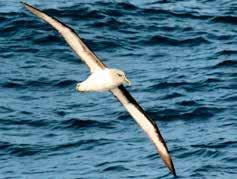
8 minute read
A South Atlantic Odyssey to A SOG exile in the South Atlantic .....Michael Bamford
A South Atlantic Odyssey
36 Tubenose species and counting
A trip from Patagonia to Ascension Island March/April 2016
I had been lately starved of the sea, so took up this voyage organised by Wildwings with Oceanwide Expeditions, on the Dutch ship Plancius, as it made its way from its Southern Ocean voyages in the Antarctic summer, to its North Atlantic summering ground. We boarded the ship on the 26th March, after I had spent a couple of days by the beautiful Beagle Channel seeing many Patagonian birds, including my first Magellanic penguin, Antarctic Fulmar, Chilean Skua, Sooty Shearwater, Kelp Gull, Dolphin Gull, Imperial and Rock Shag as well as many goose and duck species. The ship was not entirely full. For economic reasons I had taken a berth in a 3-man cabin, however I found I had it to myself. Amongst the 70 or so passengers there were some die-hard birders, but many travellers with different interests, which made the trip a varied experience. There was a full complement of expert support, and our group was led by Simon Cook who mixed experience, expertise, patience and humour in a very helpful blend. The first leg of the trip was from Ushuaia to South Georgia – four days at sea in the latitude 50s, which made for some impressive ocean swells and at times fewer folk at breakfast. Ample access to the decks produced our first Wandering, Southern Royal and Black-browed Albatross, and, as we neared South Georgia, Grey-headed and then the charismatic Light-mantled Sooty Albatross. We were accompanied by Southern Giant and Cape Petrel, our first prions – Antarctic and Slender-billed. Petrels included: White-chinned, Soft-plumaged and Wilson’s Storm Petrel plus both Magellanic and Common diving Petrels, and at South Georgia Grey-backed and Black-bellied Storm Petrel as well as Antarctic Tern. Three days on and around South Georgia made for a remarkable experience, with unseasonably sunny weather; visiting the old whaling station at Grytviken and the grave of Ernest Shackleton. We made two RIB landings on the King Penguin colonies at Salisbury Island, and St Andrew’s Bay, where huge colonies of late season birds and chicks mixed with Antarctic fur seals, and were remarkably tolerant of our presence. The colonies were accompanied by scavenging Pale-faced Sheathbills, Brown Skuas and Giant Petrels, including white phase birds. Small numbers of Gentoo and Macaroni Penguins were seen at different colonies, and we saw the endemic South Georgian Pintail and South Georgian Pipit – the most southerly passerine in the world. A landing at Prion Island showed nesting Wandering Albatross and Southern Giant Petrel. Apart from its rugged beauty and history, South Georgia has recently been declared free of rats following an extended eradication programme, and bird populations are
already beginning to respond, with the main island breeding of South Georgia pipits restored. A trip before leaving to the increasingly stormy Drygalski Fjord brought our first icebergs as well as glimpses of Chinstrap Penguin and Blue Petrel. Leaving South Georgia towards Tristan da Cunha, the ship took a course close to the Antarctic Convergence, where nutrientrich water gave our first cetacean views – Hourglass and Dusky dolphin, Fin whale, Orca, and Southern Right whale. We sailed to Gough Island, a wildlife reserve and UNESCO World Heritage site, but whose breeding population of Tristan Albatross is being ravaged by predatory mice, which eat the chicks alive. Rough weather made it impossible to sail too close to the shore, but we began to see breeding specialities, including Atlantic, Great-winged, Spectacled and the spectacular swooping flight of Kerguelen Petrels, Yellow-nosed and Sooty Albatross, Broad-billed Prions, White bellied Storm Petrels and Great Shearwaters. We were close enough to see a raft of Northern Rockhopper Penguins in their northernmost breeding habitat. Tristan Albatross were more problematic to identify at sea, but were undoubtedly in the mix! The additional ID problem was the potential new ‘split’ subspecies of Broad-billed Prion, which appears to be a relative of MacGilvray’s Prion, and which some managed to photograph at sea. The weather improved as we neared Tristan da Cunha, which made a landing at Edinburgh of the Seven Seas more likely (a third of these trips fail to make a landing). Tristan da Cunha is a unique and charming island: the most remote populated island on the globe, with around 360 inhabitants, subsisting on farming and the export of Tristan rock lobster via South Africa. We were very hospitably entertained, and I managed a game of golf on this most remote of golf courses. Whilst there we were denied a landing by sea conditions on the aptly named Inaccessible Island although we clambered ashore and climbed the steep tussock grass hills of Nightingale Island, where we were bombarded by nesting Great Shearwaters struggling into the air, as we walked past nesting Yellow-nosed Albatross, having our kit inspected by the endemic Tristan Thrushes. At the apex of the hill was a clump of phylica arborea bushes, which harbour the exceedingly rare endemic Wilkins’s Finch, which showed well and obliged for photographs. Leaving Tristan we headed for the warmer waters towards St Helena. Species numbers declined. The last tubenoses to leave our wake were the Spectacled Petrels, but as we neared St Helena, Madeiran Storm Petrels and Red-billed Tropicbirds put in an appearance. Closer to St Helena a sperm whale surfaced and fluked, and at anchor we were accompanied by rough-toothed and pantropical spotted dolphin and a leisurely appearance was made under the ship by an enormous whale shark. On shore were the obligatory St Helena Plover – the ‘Wirebird’ – which has recovered numbers following the removal of feral cats, and White Terns around Napoleon’s first tomb. An inshore sea trip brought Brown and Black Noddy, as well as Brown and Masked Booby.
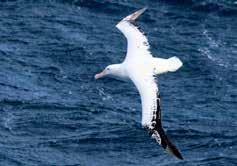
Grey-headed Albatross
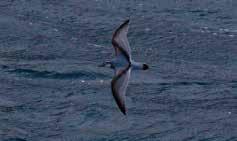
Our leaving St Helena coincided with the inaugural flight to the ill-fated new St Helena airstrip, which was immediately closed because of unforeseen air turbulence. If it reopens for passenger flights, St Helena will be a delightful destination with much to offer. The sea passage towards Ascension Island was a calmer and altogether warmer passage with few pelagic bird species, however a pod of false killer whales and numerous flying fish – as well as the novel neon flying squid – maintained interest and photo opportunities. Ascension Island is a very barren tropical volcanic island, but it has a spectacular breeding colony of Sooty Terns, and the densely populated Boatswain Bird Island has extensive breeding colonies of the endemic and dramatic Ascension Frigate birds, as well as Red-footed Boobies and White-tailed Tropicbirds. I and several others left the trip after a hugely enjoyable month at sea, and flew by
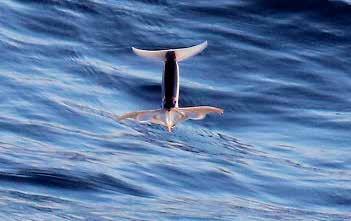
Neon flying squid Ommastrephes bartramii Red-footed Booby RAF transport back to Brize Norton. Others travelled on to the Cape Verde Islands, where further birding opportunities were promised. The trip was very efficiently arranged through Wildwings: www.wildwings. co.uk, and Oceanwide expeditions: www. oceanwide-expeditions.com 26th March – 22nd April 2016. For information on the RSPB programme to restore Gough Island: https://rspb.org.uk/ whatwedo/projects/details/419512-goughisland-restoration-programme I have appended a personal species list, which is not exhaustive, as others saw more than I did.
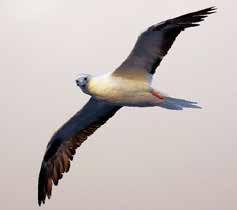
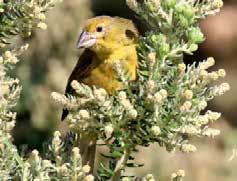
Broad-billed Prion
Bird species: 1. White tufted grebe................................ Rollandia rolland 2. King Penguin ...........................Aptenodytes patagonicus 3. Gentoo Penguin.....................................Pygoscelis papua 4. Northern Rockhopper Penguin .......................E. moseleyi 5. Macaroni Penguin ....................................E. chrysolophus 6. Magellanic Penguin.................. Spheniscus magellanicus 7. Chinstrap penguin .......................... Pygoscelis Antarctica 8. Black-browed albatross .........Thalassarche melanophris 9. Wandering Albatross.......................... Diomedea exulans 10. Tristan Albatross ......................................... D. dabbenena 11. Southern Royal Albatross.........................D. epomophora 12. Grey-headed Albatross ............................ T. chrysostoma 13. Atlantic Yellow-nosed Albatross.......... T. chlororhynchos 14. Sooty Albatross...................................... Phoebetria fusca 15. Light-mantled Sooty Albatross ...................P. palpebrata 16. Southern Giant Petrel..................Macronectes giganteus 17. Northern Giant Petrel............................................ M. halli 18. Southern (Antarctic) Fulmar ......... Fulmarus glacialoides 19. Cape Petrel (Pintado).............................Daption capense 20. Great-winged Petrel.................. Pterodroma macroptera 21. Atlantic Petrel.....................................................P. incerta 22. Kerguelen Petrel..........................................P. brevirostris 23. White-headed Petrel..........................................P. lessoni 24. Soft-plumaged Petrel.......................................... P. mollis 25. Blue Petrel ........................................Halobaena caerulea 26. Broad-billed Prion ................................Pachyptila vittata 27. MacGillivray’s Prion..................................P. macGillivrayi 28. Antarctic Prion .................................................P. desolata 29. Slender-billed Prion.......................................... P. belcheri 30. Fairy Prion............................................................. P. turtur
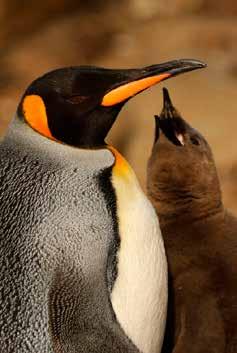
King Penguin and chick
31. White-chinned Petrel ...............Procellaria aequinoctialis 32. Spectacled Petrel.......................................P. conspicillata 33. Grey Petrel......................................................... P. cinerea 34. Cory’s Shearwater ......................... Calonectris diomedea 35. Great Shearwater ......................................Puffinus gravis 36. Sooty Shearwater...............................................P. griseus 37. Sub-Antarctic Little Shearwater....................... P. elegans 38. Wilson’s Storm-petrel.......................Oceanites oceanicus 39. Grey-backed Storm-petrel .......................Garrodia nereis 40. Black-bellied Storm-petrel......................Fregetta tropica 41. White-bellied Storm petrel ..............................F. grallaria 42. Madeiran Storm-petrel....................Oceanodroma castro 43. Common Diving-Petrel................. Pelecanoides urinatrix 44. Magellanic Diving-petrel............Pelacanoides magellani 45. South Georgian Diving-Petrel ....................... P. georgicus 46. Red-billed Tropicbird ........................Phaethon aethereus 47. White-tailed tropic bird.......................Phaethon lepturus 48. Masked Booby.......................................... Sula dactylatra 49. Brown Booby.............................................. S. leucogaster 50. Red-footed Booby ...............................................Sula sula 51. Imperial Shag ...............................Phalacrocorax atriceps 52. Neotropical Cormorant.................................P. olivaceous 53. Rock Cormorant ....................................... P. magellanicus 54. South Georgia Shag.....................................P. georgianus 55. Ascension Frigatebird................................ Fregata aquila 56. Kelp Goose............................................. Chloefaga hybrid 57. Upland Goose ...........................................Chloefaga picta 58. Flightless Steamer duck .................... Tachyeres pteneres 59. Flying Steamer duck ................................T. patachonicus 60. Crested Duck.......................... Lophonetta specularoides 61. South Georgia Pintail .................................Anas georgica 62. Speckled Teal...........................................Anas flavirostris 63. Red Shoveller...............................................Anas platalea 64. Turkey Vulture ...........................................Cathartes aura 65. Chimango Caracara..............................Milvago chimango 66. Southern Lapwing ................................ Vanellus chilensis 67. Blackish Oystercatcher ......................... Haematopus ater 68. S. American Snipe ....Gallinago paraguaiae magellanica 69. Pale-faced Sheathbill .................................... Chionis alba 70. St Helena Plover................... Charadrius sanctaehelenae 71. Brown Skua....................Catharacta antarctica lonnbergi 72. Tristan Skua................................................. C. a hamiltoni 73. Chilean Skua .................................................... C. chilensis 74. Dolphin Gull ............................................... Larus scoresbii 75. Kelp Gull.....................................................L. dominicanus 76. Brown-hooded Gull ..................................L. maculipennis 77. Antarctic Tern...............................................Sterna vittata 78. Arctic Tern....................................................S. paradisaea 79. Sooty Tern.......................................................... S. fuscata 80. White Tern ........................................................ Gygis alba 81. Black Noddy...............................................Anous minutus 82. Brown Noddy.................................................... A. stolidus 83. Dark-bellied Cinclodes...................Cinclodes patagonicus 84. Fire-eyed Diucon ........................................Xolmis pyrope 85. Austral Blackbird..................................... Curaeus curaeus 86. Long-tailed Meadowlark............................Sturnella loica 87. Patagonian Sierra-finch.................Phrygilus patagonicus 88. South Georgia Pipit .............................Anthus antarcticus
89. Introductions: 90. Barred Ground-Dove ...............................Geopelia striata 91. Common Waxbill ........................................Estrilda astrild 92. Madagascar Fody..................... Foudia madagascariensis 93. Common (Indian) Mynah....................Acridotheres tristis 94. Java Sparrow........................................... Padda oryzivora 95. Yellow Canary.....................................Serinus flaviventris










